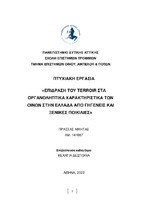| dc.contributor.advisor | Κεχαγιά, Δέσποινα | |
| dc.contributor.author | Πρασσάς, Νικήτας | |
| dc.date.accessioned | 2022-07-28T07:49:10Z | |
| dc.date.available | 2022-07-28T07:49:10Z | |
| dc.date.issued | 2022-07-21 | |
| dc.identifier.uri | https://polynoe.lib.uniwa.gr/xmlui/handle/11400/2707 | |
| dc.identifier.uri | http://dx.doi.org/10.26265/polynoe-2547 | |
| dc.description.abstract | Θέμα της παρούσας πτυχιακής εργασίας είναι η επίδραση του terroir στον ελληνικό οίνο, που παράγεται είτε από γηγενείς είτε από ξενικές ποικιλίες. Το terroir διαμορφώνεται από το έδαφος, την τοπογραφία, το κλίμα αλλά και την ανθρώπινη επίδραση. Δεν υπάρχουν σαφή όρια που να χωρίζουν μία περιοχή terroir από μία άλλη και η κλιματική αλλαγή που παρατηρείται τις τελευταίες δεκαετίες έχει αποσαφηνίσει ακόμη περισσότερο αυτά τα όρια. Στον Ελλαδικό χώρο υπάρχουν σύμφωνα με την νομοθεσία 11 αμπελουργικές ζώνες και έχουν αναγνωριστεί 33 ζώνες παραγωγής οίνων Προστατευόμενης Ονομασίας Προέλευσης (ΠΟΠ) και 120 ζώνες παραγωγής οίνων Προστατευόμενης Γεωγραφικής Ένδειξης (ΠΓΕ). Το terroir προσδίδει μοναδικά χαρακτηριστικά στον ελληνικό οίνο. Σύμφωνα με έρευνες που έχουν πραγματοποιηθεί την τελευταία δεκαετία, το διαφορετικό φαινολικό προφίλ και η διαφορετική περιεκτικότητα σε μεταλλικά στοιχεία ενός οίνου, μπορούν λειτουργήσουν σαν αποτύπωμα, σαν ταυτότητα για την προέλευση του οίνου. Το προφίλ των αρωματικών ενώσεων και των ανθοκυανινών, ακόμη και μεταξύ οίνων ίδιας ποικιλίας, καθορίζεται από τη γεωγραφική προέλευση και τις ιδιαίτερες κλιματολογικές συνθήκες που επικρατούν σε κάθε περιοχής καλλιέργειας. Κατά συνέπεια, το terroir συμμετέχει σημαντικά στη διαμόρφωση της ποιότητας ενός οίνου, ενώ παράλληλα προσδίδει ένα ευδιάκριτο χαρακτήρα με χαρακτηριστικά οργανοληπτικά γνωρίσματα. Η ανάπτυξη μεθόδων ανάλυσης όπως η φασματοσκοπία πυρηνικού μαγνητικού συντονισμού (NMR), η φασματομετρία μαζών επαγωγικά συζευγμένου πλάσματος (ICP-MS) και η μέθοδος ανάλυσης κυρίων συνιστωσών (PCA) καθιστούν ακόμη πιο εύκολη αυτή την αναγνώριση. | el |
| dc.format.extent | 60 | el |
| dc.language.iso | el | el |
| dc.publisher | Πανεπιστήμιο Δυτικής Αττικής | el |
| dc.rights | Αναφορά Δημιουργού - Μη Εμπορική Χρήση - Παρόμοια Διανομή 4.0 Διεθνές | * |
| dc.rights.uri | https://creativecommons.org/licenses/by-nc-sa/4.0/deed.el | * |
| dc.subject | Terroir | el |
| dc.subject | Οίνος | el |
| dc.subject | Ποικιλίες | el |
| dc.subject | Κλίμα | el |
| dc.subject | Έδαφος | el |
| dc.subject | Προέλευση | el |
| dc.subject | Αποτύπωμα | el |
| dc.subject | Φαινολικό προφίλ | el |
| dc.subject | Φασματομετρία | el |
| dc.subject | Κλιματική αλλαγή. | el |
| dc.subject | Wine | el |
| dc.subject | Climate | el |
| dc.subject | Climate Change | el |
| dc.subject | varieties | el |
| dc.subject | soil | el |
| dc.subject | origin | el |
| dc.title | Επίδραση του Terroir στα οργανοληπτικά χαρακτηριστικά των οίνων στην Ελλάδα από γηγενείς και ξενικές ποικιλίες | el |
| dc.title.alternative | The effects of Terroir in organoleptic characteristicts of Greek wines from indigenous and international varieties | el |
| dc.type | Πτυχιακή εργασία | el |
| dc.contributor.committee | Ευαγγέλου, Αλεξάνδρα | |
| dc.contributor.committee | Σεχάντε, Αντνάν | |
| dc.contributor.faculty | Σχολή Επιστημών Τροφίμων | el |
| dc.contributor.department | Τμήμα Επιστημών Οίνου, Αμπέλου και Ποτών | el |
| dc.description.abstracttranslated | The subject of this dissertation is the effect of terroir on Greek wine, produced either by native or foreign varieties. The terroir is shaped by the soil, the topography, the climate but also the human influence. There are no clear boundaries separating one terroir area from another, and climate change in recent decades has further clarified these boundaries. In Greece, according to the legislation, there are 11 viticultural zones and 33 zones of production of wines with Protected Designation of Origin (PDO) and 120 zones of production of wines with Protected Geographical Indication (PGI) have been identified. The terroir gives unique characteristics to the Greek wine. According to research conducted in the last decade, the different phenolic profile and the different content of minerals in a wine, can act as a footprint, as an identity for the origin of the wine. The profile of aromatic compounds and anthocyanins, even among wines of the same variety, is determined by the geographical origin and the particular climatic conditions prevailing in each growing area. Consequently, the terroir participates significantly in shaping the quality of a wine, while at the same time giving it a distinct character with characteristic organoleptic features. The development of analysis methods such as nuclear magnetic resonance spectroscopy (NMR), inductively coupled plasma mass spectrometry (ICP-MS) and principal component analysis (PCA) make this recognition even easier. | el |


